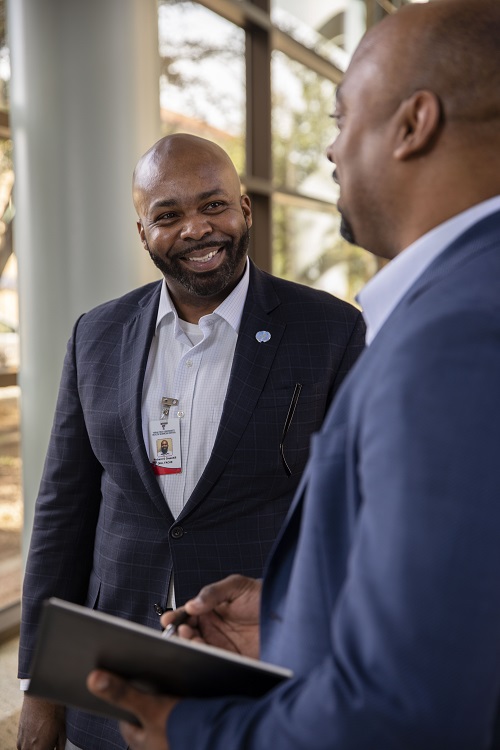The Impact of Leadership on Organizational Culture
In healthcare, bad leadership can manifest itself into poor quality of care

Many of us have answered to a bad boss throughout the course of our careers. A bad boss can make any job or career a chore, while an effective leader creates a positive environment for every employee on the team.
A few key points about professional culture:
- Organizational culture encompasses the values, expectations and practices that inform the actions of all team members across every level of the organization.
- A great culture exemplifies positive traits that contribute to improved performance.
- A dysfunctional culture leads to qualities that will hinder even the most successful organizations.
We’ve heard the expression, “It starts from the top,” and it’s true. We spoke with John Pearson, DHA, Assistant Professor in the Department of Healthcare Leadership & Management of the TTUHSC School of Health Professions, about the crucial role leadership plays in shaping organizational culture.
Situational Leadership

Having spent 26 years in the military prior to entering the healthcare management field, Pearson has seen every style of leader imaginable, ranging from autocratic to democratic to charismatic.
“With the military as my predominant experience, I’ve developed a situational leadership style,” Pearson says. “There are times when you need to be autocratic. Other times, you get folks together to brainstorm the best course of action and use input from team members for decisions.”
Other times, Pearson lets other leaders on the team have a greater say in the approach taken based on their expertise.
What style of leadership has a negative impact on culture?
“I am not a fan of those with a bureaucratic leadership style,” Pearson says.
Leaders who are policy-driven tend to see things in black and white terms, while there are a lot of decisions that end up falling into a grey area, especially when dealing with individuals.
“Folks who try to lead by the book tend to have more issues because they don’t give themselves flexibility or adaptability,” Pearson explains. “It’s not bad in every situation, but if you try to be policy-driven in every approach, it has a tendency to rub some people the wrong way.”
Pearson believes that charismatic situational leadership sets the tone for measuring and rewarding the type of behavior that an organization strives to achieve.
“Charismatic leaders have a way of getting people to be innovative and think outside the box,” he says. A charismatic leader with a situational approach has the ability to embody the values and cultural aspects by which they want their employees to live.
“Employees are happier at work and motivated to do a good job without being micromanaged,” he says.
Can Positive Leadership be Taught?

Pearson believes that positive leadership can be taught. While there are some innate qualities that all leaders possess, such as accountability and drive, he also thinks that all good leaders like to “open the aperture” to learn new qualities on how to lead.
“In the military, there are leadership schools that teach inclusivity, mission focus, respect for others and effective time management,” Pearson says. “Leaders can be taught, but they do have innate qualities that make them successful.
“There are many tools out there to determine what type of personality you have,” he continues. “Some leaders are extroverts, some are introverts, but you might never know because they have an uncanny way of getting folks to do what needs to be done.”
Damage Done by Poor Leadership
Pearson states that some people just don’t have the ability to be effective leaders.
“Those are the folks who unfortunately are sometimes promoted and move ahead of others,” he says. The collateral damage of poor leadership includes unhappy employees, low morale and office gossip, which is never good for an organization’s culture. This means that goals and objectives are not being met.
“In healthcare, that can manifest itself into poor quality of care,” he warns. It is vital for leaders to be competent, inclusive and have a clear vision.
“It’s important to realize that leaders are at every level of an organization, not necessarily just the executive level,” he says. However, the leadership at the top is what sets the tone and the culture.
As we said before: It starts from the top.
Related Stories
Celebrating Veterans: TTUHSC’s General Martin Clay’s Legacy of Service and Leadership
From his initial enlistment in the Army National Guard 36 years ago to his leadership in military and civilian health care management roles, Major General Martin Clay’s career has been shaped by adaptability, mission focus and service to others.
Texas Tech University Health Sciences Center School of Nursing Named Best Accelerated Bachelor of Science in Nursing Program in Texas
The TTUHSC School of Nursing Accelerated Bachelor of Science in Nursing (BSN) program has been ranked the No. 1 accelerated nursing program in Texas by RegisteredNursing.org.
TTUHSC Names New Regional Dean for the School of Nursing
Louise Rice, DNP, RN, has been named regional dean of the TTUHSC School of Nursing on the Amarillo campus.
Recent Stories
TTUHSC Cancer Researcher Honored by National Academy of Inventors
C. Patrick Reynolds, M.D., Ph.D., director of the School of Medicine Pediatric Cancer Research Center at TTUHSC, has dedicated his life as a researcher to developing treatments for childhood cancers.
TTUHSC School of Nursing Celebrates 10 Years of the Veteran to BSN Program
The TTUHSC School of Nursing recognized the 10-year anniversary of the Veteran to Bachelor of Science in Nursing (VBSN) program during the fall 2025 commencement ceremonies held Dec. 13 in Lubbock, Texas.
TTUHSC Dean to be Inducted into the National Academies of Practice as Distinguished Fellow
Gerard E. Carrino, Ph.D., MPH, dean of the TTUHSC Julia Jones Matthews School of Population and Public Health, will be inducted into the National Academies of Practice (NAP) as a Distinguished Fellow of the Public Health Academy.
